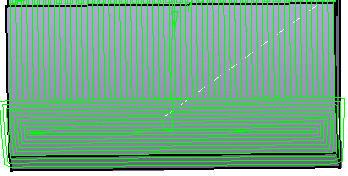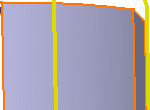Machining/Slope Area | ||||
|
| |||
Geometry
- Name
- Assigns a name to the Machining/Slope areas feature, or keep the name proposed by default.
- Slope Area
- Creates slope areas
and gives access to the corresponding parameters.
Important: Slope area cannot be used with STL files.
From the sensitive icon, you can select the following elements:
- Part.
- Check element. The check is often a clamp that holds the part and therefore is not an area to be machined.
- Limiting contour which is the contour that defines
the outer machining limit on the part.
Important: Limiting contours are not taken into account to compute the slope areas. However, they will be taken into account while computing tool paths on those slope areas: - When you create a slope area, you associate one operation to each subset.
- The corresponding tool path is limited first by the defined subset and then by the limiting contour defined in the Machining/Slope Area Geometry tab.
A machining area can be:
- The whole part (for example, in roughing)
- A subset of the faces on the part
- A subset of faces on the part with a limiting contour.
Define
- Offset Group
- Lets you select an offset group from the list, when available.
- Tool axis

Lets you change the tool axis.- Tool
- You can either:
- Tolerance
- Machining tolerance that you want to use for the slope area.
- Offset on part
- Offset computed for the slope area with respect to the
part.
Important: Offset on part in the Geometry tab of machining operations is different from Offset on part in the Define tab of the slope area. Be aware of the following: - When you create a machining operation, the Offset on part of this operation is initialized at the same value as the Offset on part of the slope area, since you want to machine the same geometry as the one used for the slope area.
- You can modify the Offset on part of the operation, but this will not update the Offset on part of the slope area.
- You can modify the Offset on part of the slope area, but this will not update the Offset on part of the operation.
- To update both Offset on part parameters, modify both parameters.
- Overlap
- When slope areas of different types are defined, there may be a
gap between them, resulting in material left on the part.

To avoid this, you can define an Overlap, i.e. a distance on which two slope areas will cover each other, making sure that the whole part is machined:- Overlap=0, the slope areas end on the same line.

- Overlap=5, the slope areas cover each other.

- Overlap=0, the slope areas end on the same line.
- Angles
- Define three types of area on the part:
- Blue defines horizontal areas.
- Yellow defines sloping, transitional areas between vertical and horizontal.
- Red defines vertical areas.
- Lower
- Defines the lower limit of the sloping area.
- Upper
- Defines the upper limit of the sloping area.
For example, here:
- Surfaces that are considered to be horizontal go from 0 degree to 5 degrees.
- Sloping surfaces from 5 degrees to 45 degrees.
- And vertical surfaces from 45 degrees to 90 degrees.
These angles are computed with respect to the tool axis.
- Small Area
- Merges small areas in larger surrounding ones.
- Click the arrow to select a reference contour. This will computes automatically a value below which an area is considered as small and merged into a larger one.
- You can also type a value without selecting a reference contour.
- Compute
- Computes the slope areas.
- Lock and edit
- Locks the slope areas and gives access to the Edit tab.
Edit
- Deactivate

- Deactivates contours in any subsets.
- Activate

- Reactivates contours of the selected subset.
- Remove Detail

- Removes details (unwanted portion of contours) in any subset.
- Create a new subset of area

- Creates a new user subset of an area.
A context menu lets you populate the subset:
- Hide/Show
- Delete
- Copy contours
- Move contours
Note: You can add only horizontal or intermediate contours to an empty subset. You can add only contours of the same type to a subset containing contours (i.e. you can add only horizontal contours to a subset containing a horizontal contour, and only intermediate contours to a subset containing an intermediate contour).A list lets you select the display color of the added set:
- Full display of area
- Once the slope areas have been computed, this check box displays them as full areas instead of lines, making overlapping areas easier to detect.
- Unlock and reset
- Cancels all computations and modifications on slope areas.
Operations
- Insertion Level
- This data is compulsory. It can be:
- An operation
- A tool change
- A Manufacturing Program.
- Assign Operation
- Displayed once the Insertion
Level is defined.
You can create a slope area:
- With no reference tool.
- If the insertion level associated to the slope area is an operation or a tool change, the associated tool is taken into account and affected to the operations of the slope area.
- If the insertion level associated to the slope area is a manufacturing program, the operations of the slope area are created with no tool.
- With a reference tool.
- If the insertion level associated to the slope area is an operation with a tool different from the reference tool, or if the insertion level is a manufacturing program, an additional ToolChange is created.
- With no reference tool.
- Assign Operation
- Assigns an operation to the machining/slope areas:
- To do so, select one area to which you want to assign an operation and define the operation parameter in the Assign Operation box that is now available.
- Use the Assign list to select one type of operation, set the Step Over value in the field below.
- To revert to an automatic step over, click Auto. The value is replaced with the label Auto.